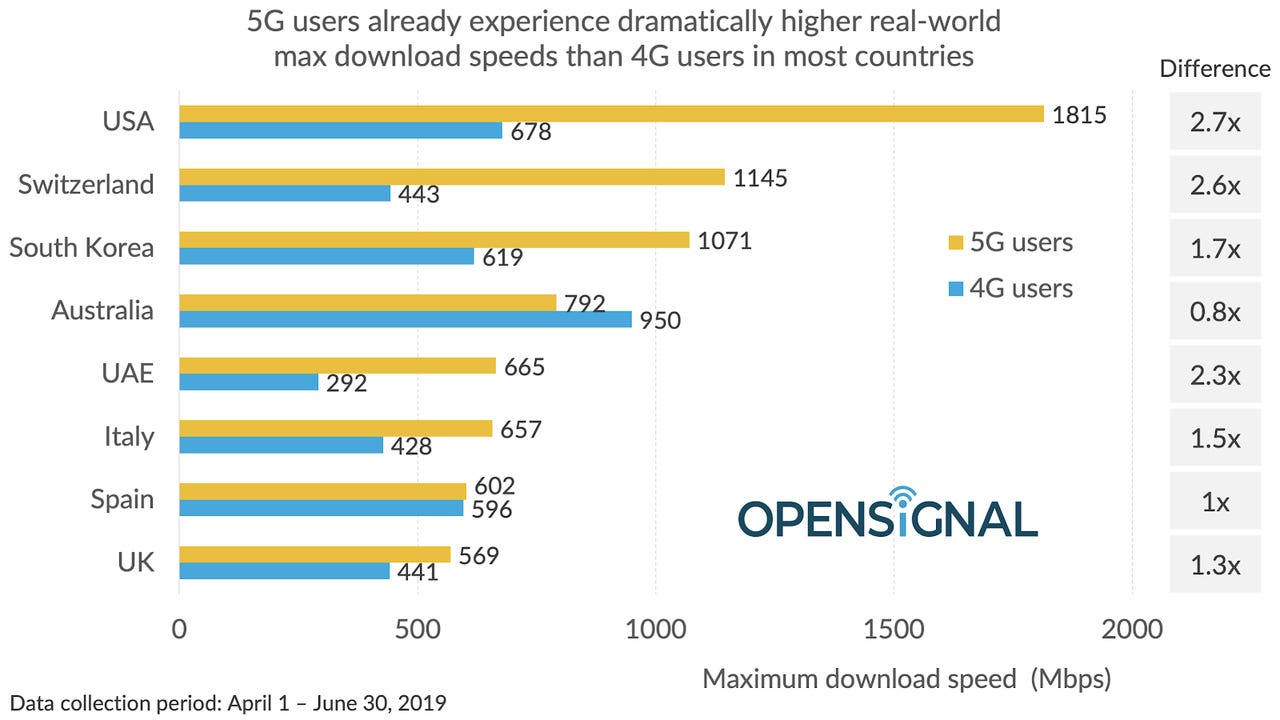4G speeds topping 5G in Australia: Opensignal


Of eight nations where Opensignal conducted real-world testing during April to the end of June, Australia is the only nation where 4G speeds were better than the much-hyped speeds of 5G.
According to Opensignal, Australia's maximum 4G network speed was 950Mbps, while 5G topped out at 792Mbps. This left it as the only country with 4G outpacing 5G, although Spain only had a 6Mbps difference between the two.
For the rest of the world, the US hit 1.8Gbps on 5G, followed by Switzerland on 1.1Gbps, South Korea just below 1.1Gbps, UAE registered 665Mbps, with Italy close by on 657Mbps, Spain just above 600Mbps, and the UK bringing up the rear with 569Mbps.
This meant 5G sits in a range of 0.8 times to 2.7 times as quick as 4G.
In tests conducted by ZDNet last month, 5G speeds failed to crack 300Mbps, with the one exception being in Telstra's Sydney headquarters.
See: Real world 5G not ready for primetime in 2019
Opensignal said the quick speed exhibited by the US was due to the use of millimetre wave spectrum.
"This is extremely high capacity and extremely fast spectrum but has very limited coverage compared with the 3.4-3.8 GHz 5G 'mid band' spectrum typically used in most of the other countries we analysed where mmWave spectrum is not yet available," it said.
For its tests, Opensignal said it wanted to look at "the true end-to-end network experience" and does not use servers located "very close" to users.
On Monday, Telstra released a set of electromagnetic energy readings on its live 5G network in Queensland that showed similar readings to 3G, 4G, and Wi-Fi.
"In the testing we completed inside apartments and cafes near our 5G Innovation Centre at Southport on the Gold Coast, we measured 5G EME levels consistently under 0.02% of the ARPANSA standard limit -- that is more than 5000 times below the safety limit put in place by the Australian government body responsible for EME," Telstra principal EME strategy, governance and risk management Mike Wood said.
"It is also important to note that existing safety standards for EME cover 5G, including children, are conservative and will also include the higher mmWave frequencies to be used in the future."
Telstra presented its data to the World Health Organisation and International Electrotechnical Commission.
Related Coverage
- 5G: If you want it this year, Huawei is the only game in town, says Three
- Vodafone switches on 5G network in the UK, introduces new plans for businesses
- Samsung: You won't be using smartphones in 5 years
- Telstra upgrades transmission network to 100Gbps minimum
- Samsung and SK Telecom succeed in 5G standalone core test
- How will mmWave technology limit deployments of 5G to rural and suburban communities? (TechRepublic)
- 5G vs. Gigabit LTE: 79% of organizations don't know the difference (TechRepublic)